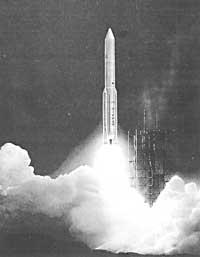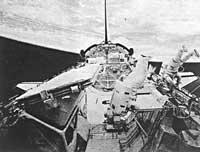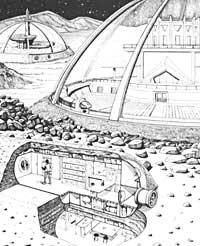Trips in Izarra
1987/12/01 Etxeberria, E. Iturria: Elhuyar aldizkaria

We are now beginning to conduct studies beyond our atmosphere. The powerful gravities of Pioneer 10 and 11 and Voyager 1 and 2 Jupiter are already accelerated or about to leave the solar system. Their speed will be around 9 kilometers per second and in this proportion they would need thousands of years to approach the nearest star.
Can we go further and become the real examiner of the stars? So what propulsion method could we use? What problems do we face?
Launcher and propulsion
It seems that the only practical method to launch a boat is the shooter. And the only practical type of launcher we have found is the chemical.
Chemical launchers function according to Newton's third law of motion, that is, each action has the same adverse reaction.
Chemical launchers burn solid or liquid fuels and in the combustion chamber the oxidizer is at a very high temperature. Exhaust gases drive the launcher at a very high speed. One of the most important properties of propulsion launchers is the push. The push of chemical launchers is relatively large, as exhaust gases are eliminated in a very high proportion. But when they are in space their appeal decreases because they consume a huge amount of fuel.
As a result, any space that runs through chemical propulsion should reserve from its initial mass a significant fraction for fuel, and yet the engine keeps the thrust in very little time due to the rapid fuel consumption of the engine.
In the future we will use this type of launchers. Over the next century we will continue to use it in low-level events and to manage space. But in interstellar journeys, chemical propulsion launchers are totally inadequate: other technologies must be put into play.
Success Formula
Considering the huge distances between the stars, the fastest space today also has the spleen march. Pioneer 10, for example, will reach a final speed of about 32000 km/h. In this proportion, the boat would take 140,000 years to reach the nearest star if it goes in a direct direction. It is not exciting. But a simple formula tells us how to improve this situation:
v f = v and log e (m i /m f)
where v f is the last speed of the launcher, see the initial, my initial mass and mf the last.

Chemical launchers can reach an initial speed of 4 kilometers per second. For the final speed to be high (m i /m f) the ratio increases. One of the ways to cut this mass ratio (in this way, with the same amount of fuel a greater useful mass would be obtained) is the use of fractional launcher. Each part can be discarded after use. This mass loss can help, but not enough for interstellar practical travel.
Launcher systems based on the nuclear fission reactor or ion conduction have already been tested. The idea behind the fission is to pump a fluid like liquid hydrogen from the fuel tank through the nuclear reactor area. This fluid becomes a very hot gas that is expelled by pushing the launcher. However, the resulting speed is not as high as a space requires.
For its part, the ion launcher projects a current of charged particles such as cesium ions, first accelerating the particles in an electric field equipped with fission reactors. However, the escape speed (about 50 km per second) is insufficient for the flight to the stars.
One day it will be possible to develop ion launchers with exhaust speeds of 1000 kilometers per second, but these launchers would not solve all problems either.
The speed that a space would need to complete the interstellar flight can be achieved using the fusion launcher. However, the generation of fusion reactions involves an increase in the temperature of hydrogen plasma by more than 100 million Kelvin. A thorny problem to correct in the future.
A variation of the basic theme of fusion is the nuclear pulse launcher, the foundation of the Daedalus Project, the ship design proposed by the British Interplanetary Society.
Journey to the stars
Simple fusion reactions are not the end of the problem, as Einstein's relativity also appears on the stage. According to this theory, high-speed space decreases time alongside an object at lower speed. On high-speed boats the clocks circulate more slowly than on Earth. But this is not all, as at such high speeds the measures are shortened and the masses increase.
The scale of these effects is really dramatic at very high speeds. If space has 10 percent of the speed of light, things won't change much: For example, Daedalus watches will only lose 18 seconds per hour.
If the speed of the ship is three or a quarter of the speed of light, the consequences of relativity are evident. The time of the ship will be two-thirds of the Earth. The ship, in the direction of the movement, will reduce a third of its size and its mass will be 1.5 times greater.

This, of course, introduces new possibilities: if a very high-speed launcher reduces the time for astronauts, the prospects of travelling to the stars become more attractive.
Traveling 270,000 kilometers per second and leaving aside the need for acceleration and deceleration time, the crew can reach Proxima Centauri in 23 months. If we add eighteen months to do the exam, the crew will take about five years to complete the entire event. But eleven years would pass on Earth. On longer trips and at higher speeds the situation is even more dramatic. The Syrian would be enough nine months of astronaut life to move at a speed of 99.9 percent of the light speed (5.3 parsec). But when they return to earth, Sirius' crew discovers that seventeen years have passed.
In 17 years technology and society can change, but perhaps not drastically. But imagine what can happen at such a speed to the center of the galaxy, 10,000 parsec. According to astronauts, the trip could last about 3000 years. On Earth, however, it would be 65,000 years!
Retroreactor to the stars
After conducting a series of tests through the nuclear pulse launcher, ship designers will seek to find something much faster. Interstellar retroreactor (ISR) looks like an intelligent option.
About 25 years ago R.W. Bussard outlined the idea that space would use the interstellar medium itself as a fuel source. Using a mesh tool, the ship would create in its front a powerful magnetic field of thousands of kilometers. This magnetic field would attract all hydrogen ions in the area, which would be used in the fusion reactor located inside the vessel.
According to Bussard, the retroreactor (ISR) could achieve an ideal acceleration of 1-g if its surface goes from 10,000 square kilometers of high ion density to 10,000,000 square kilometers of low density.
With the retroreactor, the more speed the better. Increased speed reduces the distance between two points of space. At this point the perspectives of terrestrial and fleet researchers would not be matched. According to this, the higher the speed at which the retroreactor moves, the greater the proximity of its frontal ions. At a speed of 99.9 percent of the speed of light, the ions between Earth and the galactic zone (10,000 parsec) would appear stacked in a cylinder of 450 parsec.
There are wonderful possibilities for the retroreactor. Imagine such a ship leaving the solar system with a nuclear pulse launcher. In a few months it will launch a net trick, attracting few hydrogens at first, but ingesting more and more as time progresses. Relative distance compression attracts more and more ions into the network and the engine feeds on continuously growing fuels. But it also has an opposite effect and is that the mass of the retroreactor also has to increase. Consequently, this push that is added does not serve to gain speed.

All this has nothing. Imagine that with a reactor of these characteristics it is possible that the distances of the universe circulate within a few months, days and hours. Thus, it would be a one-way trip for travelers. Crew members could not return home, at least to the house they know.
Colonization of stars
The human being will certainly go into space, first colonizing the nearby worlds: a base on the moon with the observatories and the hotel; a smaller base on Mars: perhaps a scientific headquarters in Ganimide, followed by Titan and Triton, further afield.
And then the stars. After tests like Daedalus have completed their study work, 61 Cygni, Tau() Ceti or Sigma Pavonis, located 6 parsec off Earth, could be the following destinations. Later, using ISR (Interstellar ram-jet) technology, we can talk about ten parsec and after percentages.
As human beings go to the Galaxy, they must adapt to the conditions they encounter. Perhaps by the influence of other ingenious beings new cultures, ethical, scientific and artistic can be created. Changing the Homo Sapiens physically and intellectually to adapt it to new environments can be associated with other lines of evolution.
And all this can happen in a very small part of the Milky Way Galaxy, a discoidal collection of 200 billion stars and one of the billions of galaxies in the universe. Although the human condition comes to colonize the nearest stars, the journey into the space of our species will only begin.

Gai honi buruzko eduki gehiago
Elhuyarrek garatutako teknologia





